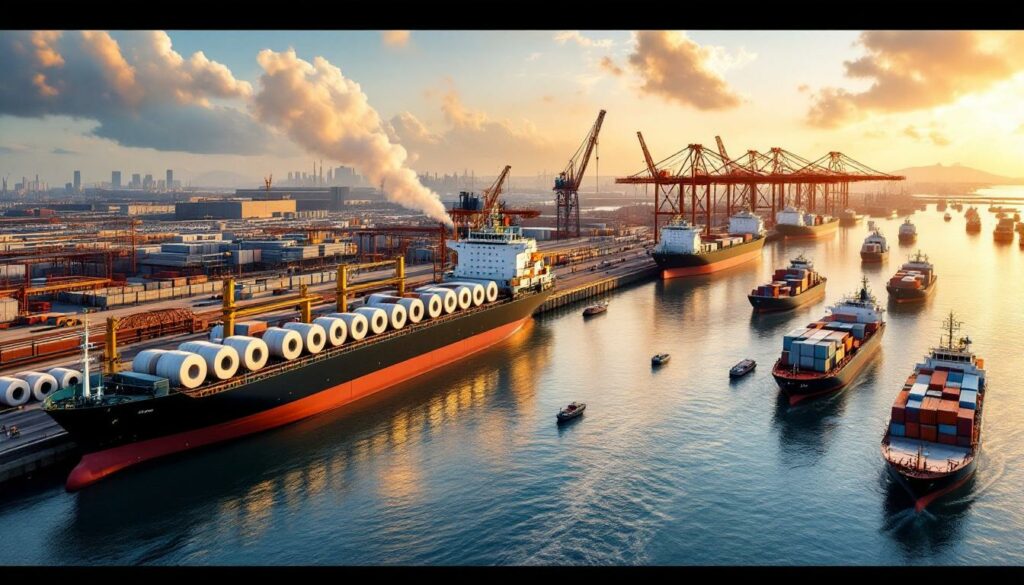China's Steel Export Performance in H1 2025: Analysis and Market Impact
China's steel exports have shown remarkable resilience and growth during the first half of 2025, despite global economic uncertainties and trade challenges. The export data reveals significant trends that impact both domestic and international steel markets, with implications for producers, consumers, and policymakers worldwide.
How Did China's Steel Exports Perform in the First Half of 2025?
Steel Export Volume Reaches 58.147 Million Metric Tons
According to data from the General Administration of Customs of China (GACC), Chinese steel mills exported 58.147 million metric tons in the first half of 2025, representing a substantial 9.2% year-over-year increase. This growth trajectory underscores China's continued dominance in global steel markets despite various international trade challenges and changing economic conditions.
The robust export performance demonstrates China's steel industry resilience and technological advancement, enabling producers to maintain strong international market presence even as global competition intensifies. Chinese mills have continued to optimize production efficiency and product quality, allowing them to capture market share in regions with growing infrastructure development.
Industry Insight: "China's ability to sustain export growth while simultaneously managing domestic demand reflects the maturity of its steel industry's supply chain management and market responsiveness," notes industry expert Li Wei from the China Metallurgical Industry Planning and Research Institute.
Monthly Export Trends Show Recent Cooling
June 2025 witnessed steel exports reaching 9.678 million metric tons, marking an 8.5% month-on-month decrease—approximately 900,000 metric tons less than May's figures. This monthly decline suggests potential market adjustments following several months of strong performance.
The cooling in June exports appears to be influenced by several factors:
- Seasonal demand patterns in key import markets, particularly construction slowdowns during summer months
- Logistics constraints at major ports during the mid-year shipping peak
- Inventory adjustments by overseas buyers who had previously stockpiled Chinese steel
- Preliminary responses to trade policy shifts in key destination markets
Industry analysts suggest this monthly fluctuation represents a normal cyclical pattern rather than a fundamental shift in export capacity or strategy, though continued monitoring will be necessary to identify any emerging trends.
What Factors Are Driving China's Steel Export Growth?
Domestic Economic Policies and Financial Environment
China's aggregate social financing reached 22.83 trillion yuan in H1 2025, showing a substantial increase of 4.74 trillion yuan compared to the same period in 2024. This expanded financing, coupled with 12.92 trillion yuan growth in Renminbi loans, has created a supportive environment for industrial production and export activities.
The People's Bank of China (PBOC) reports that M2 money supply expanded by 8.3% year-over-year by the end of June 2025, indicating a favorable liquidity environment that benefits steel producers. Additionally, the central bank conducted 1.4 trillion yuan of reverse repo operations on July 15, 2025, ensuring sufficient liquidity in the banking system to support industrial sectors.
This monetary support translates to several tangible benefits for steel exporters:
- Lower borrowing costs for capacity maintenance and expansion
- Enhanced working capital availability for export-oriented production
- Improved financing terms for international trade operations
- Greater flexibility in offering competitive payment terms to overseas buyers
Infrastructure Investment Momentum
Railway construction has maintained rapid progress in the first half of 2025, with fixed asset investment reaching 355.9 billion yuan, up 5.5% year-over-year according to China State Railway Group. This robust infrastructure development has stimulated domestic steel demand while allowing producers to maintain high production levels that support export capabilities.
The commissioning of 301 kilometers of new railway lines demonstrates China's continued commitment to infrastructure development, creating a steady domestic demand base that helps stabilize production. This stability enables producers to plan export strategies with greater confidence and consistency.
Additionally, China's new energy vehicle (NEV) sector continues its strong growth trajectory, with 5.622 million new registrations in the first half of 2025—a 27.86% year-over-year increase according to the Ministry of Public Security. This booming sector drives demand for specialized steel products while supporting broader industrial activity.
Global Monetary Policy Shifts
Market anticipation of US Federal Reserve interest rate cuts in the second half of 2025 may be influencing export strategies and international purchasing decisions. As noted by PBOC Deputy Governor Zou Lan at a recent State Council Information Office press conference:
"Markets widely expect the US Federal Reserve to resume interest rate cuts in the second half of the year… easing cycles in major developed economies will narrow monetary policy divergence between China and the US."
This evolving financial landscape potentially creates a more favorable environment for Chinese exports through multiple mechanisms:
- Exchange rate dynamics: Potential yuan stabilization or moderation against the dollar
- Global liquidity conditions: Easier access to trade financing for international buyers
- Demand recovery: Improved construction and manufacturing activity in key import markets
- Investment flows: Potential capital reallocation toward emerging markets, supporting infrastructure development
How Does China's Steel Import Performance Compare?
Declining Import Volumes
While exports have surged, China's steel imports have moved in the opposite direction. According to GACC data, China imported 470,000 metric tons of steel in June 2025, representing a modest decrease of 11,000 metric tons (2.3%) month-on-month.
More significantly, the cumulative H1 2025 steel imports totaled just 3.023 million metric tons, showing a substantial 16.4% year-over-year decline. This import reduction highlights China's decreasing reliance on foreign steel sources and the growing self-sufficiency of domestic producers across product categories.
The import decline appears most pronounced in:
- High-end automotive steel
- Specialized tool steels
- Precision stainless varieties
- Ultra-high-strength construction grades
Several factors contribute to this shift, including improved domestic production capabilities, strategic industry upgrades, and changing consumption patterns in manufacturing sectors.
Trade Balance Implications
The combination of rising exports (58.147 million metric tons) and falling imports (3.023 million metric tons) has created a significant steel trade surplus of approximately 55.124 million metric tons for China in H1 2025. This imbalance reflects China's strengthened position as a net steel exporter and may influence global market dynamics and potential trade policy responses from importing nations.
The widening trade gap has several implications:
- International trade tensions: Growing pressure for protective measures in import markets
- Resource allocation: Increased focus on securing raw materials for export-oriented production
- Price competition: Potential downward pressure on global steel prices
- Market restructuring: Acceleration of industry consolidation trends in import-dependent regions
What Are the Strategic Developments in China's Steel Industry?
Supply Chain Partnerships and Resource Security
Recent strategic developments include Xuzhou Iron & Steel Group's agreement with Shandong Weiqiao Pioneering Group for Simandou iron ore procurement. According to Shanghai Metal Market reporting, this partnership was formalized on July 10, 2025, aiming to establish stable ore supply through coordinated efforts in sourcing and logistics.
The Simandou iron ore deposit in Guinea represents a significant resource security initiative for Chinese steel producers. With estimated reserves exceeding 2.4 billion tons of high-grade ore (averaging 65% Fe content), Simandou offers several strategic advantages:
- Reduced dependency on traditional Australian and Brazilian suppliers
- Access to high-quality ore that enables more efficient steel production
- Lower impurity levels that reduce environmental impact of processing
- Diversified supply channels that mitigate geopolitical risks
This partnership demonstrates proactive measures to secure critical raw materials for steel production, potentially supporting export growth through cost advantages and supply stability.
Industry Self-Regulation Initiatives
The China Coal Transportation & Sales Association recently emphasized the need to strengthen industry self-discipline and curb "rat race" competition. These efforts to promote supply-demand balance in related markets could indirectly support more sustainable steel production and export practices by stabilizing input costs.
Industry self-regulation initiatives focus on several key areas:
- Price stabilization: Reducing volatility in coal and coke markets that impact steel production costs
- Quality standards: Maintaining minimum quality thresholds for export-grade products
- Production discipline: Avoiding overcapacity that could trigger anti-dumping investigations
- Environmental compliance: Ensuring exports meet increasingly stringent international standards
How Does China's Steel Export Growth Impact Global Markets?
Competitive Pressures on International Producers
China's expanding steel exports create significant competitive pressures for steel producers in importing countries. The 9.2% year-over-year increase in export volume may intensify concerns about market share erosion in regions heavily dependent on domestic steel production.
The impact is particularly evident in recent developments like Tata Steel's UK electric arc furnace (EAF) project—a £1.25 billion investment that includes £500 million in government funding, scheduled for commissioning by 2027. This strategic pivot toward more flexible, lower-carbon production methods represents a direct response to competitive pressures from imports.
The competitive dynamics manifest in several ways:
- Price pressure: Chinese exports often enter markets at competitive price points
- Production adjustments: Local mills reducing capacity utilization in response
- Strategic pivots: Shift toward specialized products or production methods
- Consolidation trends: Mergers and acquisitions to achieve economies of scale
- Policy advocacy: Increased calls for trade protection measures
Global Capacity Utilization Effects
The substantial volume of Chinese steel entering international markets potentially impacts global capacity utilization rates and price stability. With 58.147 million metric tons exported in just six months, the flow of Chinese steel influences production decisions and investment planning for steel manufacturers worldwide.
Global capacity utilization rates have shown significant sensitivity to Chinese export volumes, with each 5% increase in Chinese exports historically correlating with approximately 2-3% reduction in capacity utilization in import-dependent regions.
Market Insight: "The scale of Chinese exports now effectively determines global steel price trends in many product categories, creating a reference point against which other producers must position their offerings," explains steel market analyst Zhang Min.
What Are the Future Outlook and Challenges for China's Steel Exports?
Potential Trade Policy Responses
The significant growth in China's steel exports may trigger trade policy responses from importing countries seeking to protect domestic industries. Historical patterns suggest that sustained export growth could lead to increased scrutiny, potential tariffs impact markets, or other trade defense measures by major steel-importing nations.
Several factors increase the likelihood of trade policy responses:
- EU Carbon Border Adjustment Mechanism (CBAM) implementation affecting steel imports
- Precedent of prior trade actions following similar export surges
- Political pressures in importing countries facing industrial employment challenges
- WTO reform discussions potentially enabling faster trade remedy procedures
Chinese exporters will need to navigate an increasingly complex trade policy landscape, potentially requiring greater product diversification and market expansion to mitigate concentration risks.
Domestic Economic Considerations
China's domestic economic performance will remain a key factor influencing future export volumes. The current supportive monetary environment, with the PBOC conducting 1.4 trillion yuan of reverse repo operations, suggests continued liquidity support for industrial production in the near term.
However, domestic demand patterns will significantly influence the volume available for export:
- Continued infrastructure investment (railway, NEV, and power sectors)
- Real estate sector recovery pace
- Manufacturing sector expansion
- Decarbonization initiatives impacting production methods
Raw Material Supply Security
Strategic initiatives like the Simandou iron ore procurement agreement highlight the industry's focus on securing stable raw material supplies. Future export performance will partially depend on China's ability to maintain reliable access to iron ore price trends and other critical inputs at competitive prices.
The Simandou project represents a particularly significant development, as it could reduce dependency on traditional suppliers and potentially create cost advantages for Chinese producers. Industry analysts estimate that fully operational Simandou production could meet approximately 15% of China's iron ore import needs.
Disclaimer: The analysis presented regarding future trade policy responses and raw material supply developments contains speculative elements based on historical patterns and current trends. Actual outcomes may vary significantly based on geopolitical developments, policy shifts, and market conditions.
FAQ About China's Steel Export Performance
How does China's steel export volume in H1 2025 compare to previous years?
China's steel exports reached 58.147 million metric tons in H1 2025, representing a 9.2% increase compared to H1 2024. This continues a trend of expanding export volumes that has positioned China as the world's dominant steel exporter. Looking at a five-year trend, this represents approximately a 27% increase from H1 2020 volumes, demonstrating the long-term strength of China's export strategy.
What types of steel products dominate China's exports?
China's steel exports encompass a diverse product mix, with hot-rolled coils (HRC) and construction steel leading the volume. The current export breakdown includes:
- Hot-rolled coils and sheets: Approximately 32% of export volume
- Rebar and construction steel: 28% of exports
- Cold-rolled products: 17% of exports
- Galvanized and coated steel: 14% of exports
- Specialty and high-value steel: 9% of exports
Product mix variations are often strategic responses to trade defense measures in specific markets, with producers pivoting toward categories facing fewer restrictions.
How might China's steel export growth affect global steel prices?
The substantial volume of Chinese steel exports exerts significant downward pressure on global steel prices, particularly in markets where Chinese products compete directly with domestic production. The 9.2% year-over-year increase in export volume contributes to price competition in international markets.
Price impacts vary by product category and region:
- Construction steel: Most sensitive to volume pressure (-5% to -8% price effect)
- HRC and CRC: Moderate sensitivity (-3% to -6% price effect)
- Specialty steel: Limited impact due to quality differentiation (-1% to -3%)
- Regional variation: ASEAN markets typically experience the most direct price pressure
What role does China's domestic steel consumption play in export decisions?
Domestic consumption patterns significantly influence export volumes, as producers often prioritize meeting local demand before allocating production to exports. The strong railway construction activity (with 355.9 billion yuan in fixed asset investment) indicates robust domestic demand that coexists with export growth.
China's steel mills typically follow a hierarchical approach to market allocation:
- First priority: High-margin domestic orders
- Second priority: Long-term international partnerships
- Third priority: Spot export opportunities
- Production balance: Maintaining optimal capacity utilization
This approach means export volumes often represent production capacity that exceeds domestic demand, creating a countercyclical relationship between domestic consumption and export volumes.
Emerging Trends in China's Steel Export Landscape
Decarbonization Initiatives Impact Export Competitiveness
China's steel industry is increasingly focusing on decarbonization technologies that may ultimately influence export competitiveness. Early-stage hydrogen reduction pilots and carbon capture investments could eventually translate to products that meet stricter carbon footprint requirements in developed markets.
Digital Supply Chain Integration Enhances Export Efficiency
Advanced digital tracking and blockchain verification systems are being implemented across China's steel export supply chain, improving traceability from production to delivery. These technologies help verify product specifications, streamline customs processes, and enhance buyer confidence in quality consistency.
Product Specialization Shifts Export Value Proposition
Chinese producers are gradually shifting toward higher-value-added steel products in export markets, moving beyond traditional volume-based competition. This strategic evolution includes greater emphasis on precision tolerances, surface quality, and specialized alloy compositions that command premium pricing.
The iron ore demand insights from key markets continue to shape China's export strategies, while ongoing US-China trade impacts create both challenges and opportunities for Chinese steel exporters seeking to maintain their global market position.
Want to Stay Ahead of Major Mining Discoveries?
Discovery Alert's proprietary Discovery IQ model identifies significant ASX mineral discoveries in real-time, delivering actionable investment insights straight to your inbox. Explore how historic discoveries have generated substantial returns by visiting the dedicated discoveries page and start your 30-day free trial today.




